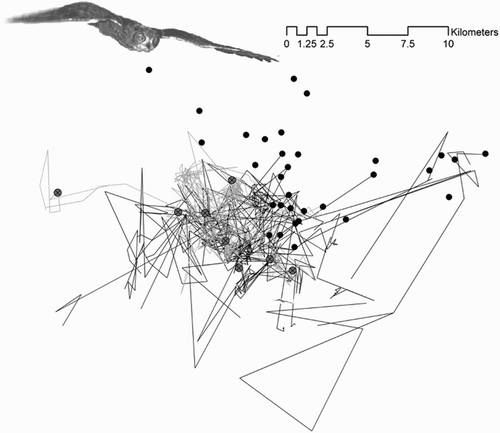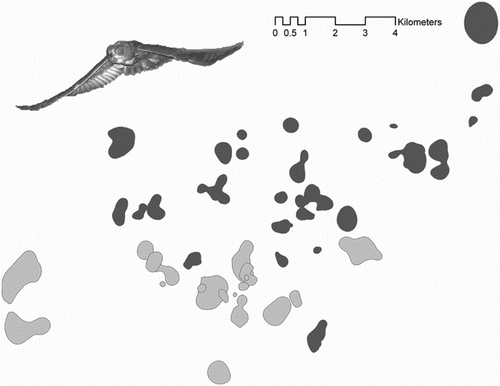Figures & data
Figure 1. Dispersal routes of radio-tagged juvenile Eagle Owls. Nesting sites are represented by black dots, except for those that have been occupied by a juvenile at the beginning of dispersal (grey dots; see text for more details). Grey lines represent individuals that encountered an available breeding site before entering the common settlement area and began to reproduce there. Black lines show the dispersal paths of the other owls, which ended in the common settlement area. Analyses showed that occupancy of a breeding site by a disperser was generally random; directions of dispersal were the only factors slightly favouring the entrance of a juvenile as a new breeder (see Results). The juveniles’ paths within the breeding area show their movements at the beginning of dispersal, when they were still living in the breeding area.

Figure 2. Home ranges of breeders (dark grey) and dispersers (light grey) obtained during continuous radio-tracking sessions (i.e. the following of focal individuals from sunset to sunrise; more details in Methods). Although the breeding and dispersal areas are very close to each other, there is a clear spatial separation between the two fractions of the population. As a consequence of this spatial segregation, dispersers should have not been able to receive information on the availability of reproductive opportunities within the breeding area without active prospecting (which they never did, see Results). Spatial segregation may be the result of breeder's territorial behaviour, which make it safer for dispersers to settle in areas empty of breeders where territoriality and intraspecific competition is lower.

Figure 3. Potential alterations to the natal dispersal dynamics determined by the emergence of a trap in the disperser's settlement areas. (A1) The breeding population (black square) is saturated because of (i) immigration from other populations, (ii) breeder redistribution within the population (i.e. breeding dispersal) and (iii) entrance of dispersing individuals from both the wandering (dark grey square) and the temporary settlement (grey square) areas (see details of the dispersal matrix in the main text). (A2) If the temporary settlement areas used during dispersal form a trap that prevents disperser prospecting for breeding opportunities, the immigration flux from the dispersal to the breeding areas stops. As a consequence, the breeding population decreases due to the loss of a portion of future potential breeders, which are now trapped in higher numbers within the dispersal matrix and do not prospect regularly for vacancies in the breeding area. Actually, after the emergence of the trap, immigration from other populations and from those individuals already settled ceases, and wandering individuals are the only immigration fluxes that breeders receive. (B) An interesting link exists between the trap mechanism we described and the attractive sink (or deceptive source) concept developed by Delibes et al. (Citation2001b). Traps in the settlement areas of dispersers may produce temporal changes within the breeding – settlement areas system that resemble the effects of an attractive sink on source populations, where the settlement areas/attractive sinks absorb most of the potential breeders from the breeding sites/source.

